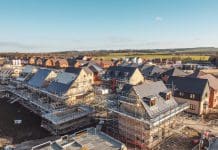With the spotlight on the UK after the landmark COP26, Ian Risk, chief technology officer at the Centre for Modelling & Simulation, believes digital engineering must be at the heart of building design if the industry is to succeed in meeting net zero goals while addressing the housing crisis
The construction and housebuilding industry has a reputation for lagging behind other sectors when it comes to carbon neutrality. Currently, construction contributes 40% of the UK’s carbon emissions – with ambitious net zero targets to meet and a housing crisis to be addressed, we must work smarter, as well as harder, to find a solution that can be applied throughout the sector.
There are already a number of initiatives out there, bringing some of the industry’s biggest names together to tackle our most pressing challenges as the sector looks to “Build Back Better”. From the Advanced Industrialised Methods for the Construction of Homes (AIMCH) project to the Construction Leadership Council’s CO2nstructZero strategy, these look into how modern methods of construction can be optimised to meet housing demand in a more affordable, eco-friendly way.
However, while it’s great to see progress being made, there is another way. Digital engineering has the potential to address carbon reduction before a single brick is laid.
Multi-objective optimisation
Digital engineering allows builders and contractors to evaluate the whole life of buildings at the design stage, enabling them to solve problems before they appear. This might include assessing materials and supply chains for sustainability wins; or even how to get the best results from brownfield sites for large-scale developments. These elements are all vital when it comes to sustainability in housing.
The digital transformation of engineering capability has the potential to be game-changing for housebuilders. At CFMS, we support developers to create better solutions and pioneer new product development by facilitating a greater understanding of how a product will perform throughout its lifecycle. To do this we use a “digital test bed” – a virtual replica of systems and processes – to investigate opportunities and determine the best option, in advance of physical development.
Through the development of this multi-objective optimisation strategy, we can help developers to balance the competing environmental, economic and societal factors that feed into a successful sustainable housing ecosystem.
The approach uses sophisticated digital modelling and simulation techniques to identify the best options before shovels break ground and any physical work begins, saving time and money, in addition to reducing the operational and embodied carbon footprint throughout both the development of, and the whole life of, the buildings.
For example, lifecycle modelling can be used to assess specific aspects of a material or component, such as corrosion. We look at how such factors change over time and how those changes will affect performance. This enables the developer to stipulate specific design requirements, thereby creating more sustainable products and minimising through-life costs for maintenance. Specific modelling approaches can also be utilised to evaluate how developments perform under “stress” – such as major environmental or unforeseen events – and then make recommendations to optimise this performance.
From a sustainability perspective, planning must evolve and be conducted holistically to meet growing environmental targets. Digital engineering can help here to establish how power and transportation resources can be shared within a development for the benefit of all.
Another major challenge for any large construction project is quickly identifying an optimised solution that meets the varying needs of architects, engineers, builders, regulators and occupiers. Multi-objective optimisation allows us to investigate a range of different complex design options in enough detail to satisfy the demands of these stakeholders. By taking a digital approach, this once time-consuming and expensive task can be managed quickly.
As the digital engineering system is automated, the solutions presented are not biased or hindered by human preconceptions. Delivering insights with full traceability also helps developers to clearly understand why specific design choices are optimal, whilst linking back to the design requirements and specification.
Beyond BIM
Although investment in research and development for the construction industry has been increasing through initiatives such as the Construction Innovation Hub, the sector could do more to innovate digitally, particularly when it comes to design and sustainability.
This has focused attention on to concepts such as design for manufacture and assembly (DfMA), modularisation and offsite mass production to improve productivity, quality and U-values. Although this is a positive move forward, there still appears to be a reluctance to use design as a vehicle for optimising the housing system as a whole. Investigating and assessing the sustainability of major developments and supply chain requirements, as well as understanding the impact of major societal or environmental changes, can have a major impact on the long-term cost and sustainability of a project and the potential return for investors and stakeholders.
The industry is valiantly collaborating to find solutions to challenges society faces but it must think outside of the box. Working with think tanks, academia and policymakers, in addition to competitors, will be key to the development and embracing of a wide-scale rollout of digital solutions to housing construction.
Digital engineering is a tried and tested approach that’s been implemented successfully in a number of sectors, from aerospace to manufacturing, delivering impactful reductions to the carbon footprint of product development and infrastructure. If the construction sector is to meet ambitious carbon targets, the path ahead needs to be streamlined. Now is the time for the house builders to embrace this evolution of BIM, as we look ahead to net zero in 2050.
Ian Risk
Chief technology officer
Centre for Modelling & Simulation
+44 (0)117 906 1100
Twitter: @CFMSuk
LinkedIn: CFMS
YouTube: CFMS UK














